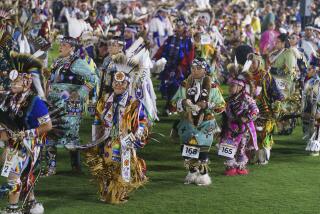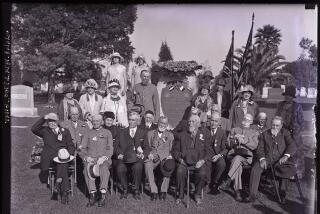Anniversary of Key Treaty in California Is Observed : Campo de Cahuenga: The document signifying the local end of the Mexican-American War eventually led to statehood.
- Share via
Without Jose Antonio Carrillo, the birth of California as an American state would have been a much more labored event.
“He wrote the Treaty of Cahuenga in Spanish and English,” said Mark Russek, 77, of Pasadena, who is related to Carrillo through his great-grandmother. “He was one of the few people available to make that contribution.”
Carrillo’s portrait hangs in the one-story adobe of Campo de Cahuenga, where the treaty marking the end of the Mexican-American War in what is now the state of California was signed Jan. 13, 1847.
Russek was one of more than 100 people attending Sunday festivities at the adobe building on Lankershim Boulevard to commemorate the 145th anniversary of the treaty signing, which eventually led to California’s statehood.
Women in historic costume served cookies. Boy Scouts from the Ta Tanka Lodge in the San Gabriel Valley performed American Indian dances. And one man even took the opportunity to describe his memories of Amelia Earhart, who lived in the area.
But the highlight of the two-hour event was the chance to look back at the treaty signing.
“We are here commemorating peace treaties,” said Russek, who has attended more than 20 of the 42 consecutive annual events. “We think it’s a shame that people know more about Olvera Street being the birthplace of Los Angeles than about Cahuenga being the birthplace of California.”
Indeed, Campo de Cahuenga is “the most important historic landmark west of the Mississippi,” according to a pamphlet written for the Los Angeles Recreation and Parks Department, which owns it.
It was at this site that the last foreign force surrendered on U. S. soil on Jan. 13, 1847, said Tom Link, an attorney who spoke at the commemoration and has written a book on local history. Gen. Andres Pico, the leader of the Mexican forces, surrendered to Lt. Col. John C. Fremont, commander of the California Volunteers.
The articles of capitulation had been written in Spanish and English the night before by Carrillo, an aide to Pico, Link said.
Carrillo was the only member of Pico’s group who spoke English. None of the four or five men in Fremont’s party spoke Spanish, Link said.
“He really was the person who was able to bring the two sides together, producing documents that the commanders could sign,” Link said.
And, when the Cahuenga treaty was signed, the California territory effectively became part of the United States, an event that the Campo de Cahuenga Memorial Assn. would like to see more people take interest in, association President Guy Weddington McReary said.
McReary said the association would like to see Campo de Cahuenga be filled with more exhibits and initiate a docent program.
“It’s the best-kept historical secret in the state, probably in the country,” he said.
More to Read
Sign up for Essential California
The most important California stories and recommendations in your inbox every morning.
You may occasionally receive promotional content from the Los Angeles Times.










